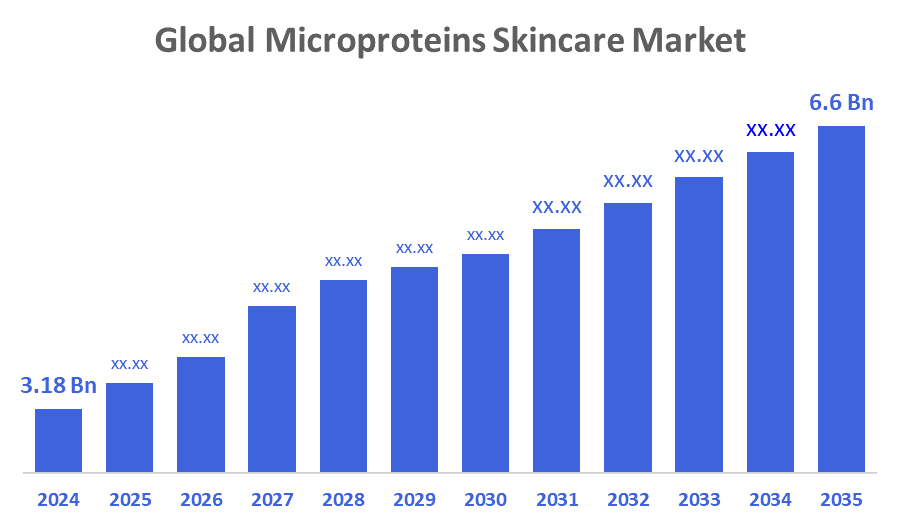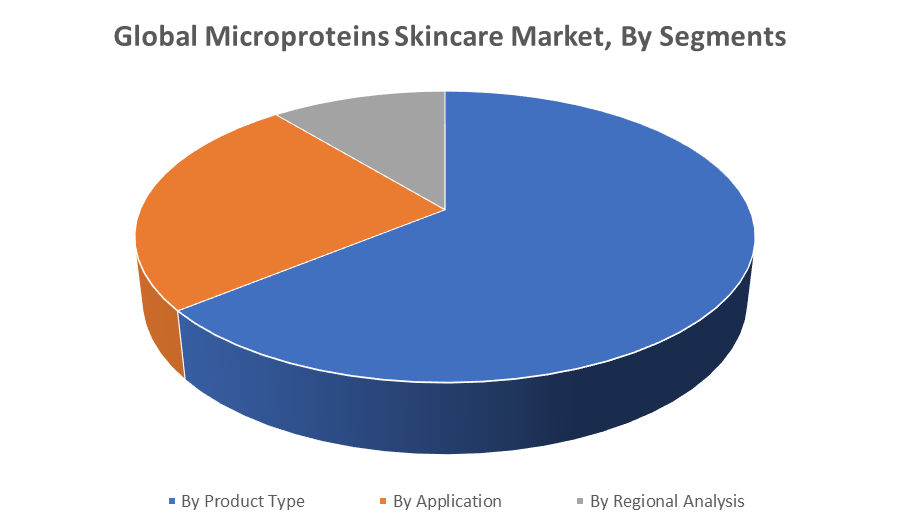Global Microproteins Skincare Market
Global Microproteins Skincare Market Size, Share, and COVID-19 Impact Analysis, Impact of Tariff and Trade War Analysis, By Product Type (Creams, Serums, Masks, and Lotions), By Application (Anti-aging, Moisturizing, Acne Treatment, and Sensitive Skin), and By Region (North America, Europe, Asia-Pacific, Latin America, Middle East, and Africa), Analysis and Forecast 2025 - 2035
Report Overview
Table of Contents
Microproteins Skincare Market Summary, Size & Emerging Trends
According to Decisions Advisors, The Global Microproteins Skincare Market Size is expected to Grow from USD 3.18 Billion in 2024 to USD 6.6 Billion by 2035, at a CAGR of 6.91% during the forecast period 2025-2035. Rising consumer preference for natural and bioactive skincare ingredients is a primary driver of this market’s growth.

Key Market Insights
- Asia Pacific is expected to account for the largest share in the microproteins skincare market during the forecast period.
- In terms of product type, the creams segment dominated in terms of revenue during the forecast period.
- In terms of application, the anti-aging segment accounted for the largest revenue share in the global microproteins skincare market during the forecast period.
Global Market Forecast and Revenue Outlook
- 2024 Market Size: USD 3.18 Billion
- 2035 Projected Market Size: USD 6.6 Billion
- CAGR (2025-2035): 6.91%
- Asia Pacific: Largest market in 2024
- North America: Fastest growing market
Microproteins Skincare Market
The microproteins skincare market focuses on bioactive protein-based formulations designed to penetrate skin layers for enhanced rejuvenation, hydration, and repair. Microproteins are valued for their ability to stimulate collagen production, improve skin elasticity, and reduce visible signs of aging. These ingredients are increasingly preferred in formulations targeting anti-aging, moisturizing, and sensitive skin care. Growing awareness of skin health, coupled with a rising demand for natural and sustainable cosmetics, supports market expansion globally. Key manufacturers are investing in R&D to develop innovative products combining microproteins with other active compounds for synergistic effects. Government regulations promoting safe and effective skincare products encourage transparency and ingredient efficacy.
Microproteins Skincare Market Trends
- Increasing demand for natural and bioactive skincare ingredients.
- Development of multifunctional products combining microproteins with vitamins and antioxidants.
- Rising consumer focus on anti-aging and sensitive skin treatments.
Microproteins Skincare Market Dynamics
Driving Factors: Growing consumer awareness about skin health and preference for natural ingredients
The microproteins skincare market is fueled by increasing awareness of skin health and demand for natural, gentle products. With rising cases of skin sensitivity and aging populations, consumers are turning to bioactive ingredients like microproteins. Expanding personal care industries in Asia Pacific and North America support growth. Technological advancements in delivery systems enhance product absorption and effectiveness. Additionally, the market benefits from strong trends favoring sustainable, cruelty-free formulations and clean-label skincare solutions.
Restrain Factors: High production costs and limited awareness in developing regions
The market faces limitations due to high production and formulation costs of microprotein-based products, making them less accessible to price-sensitive consumers. In developing regions, low awareness and skepticism toward newer, bioactive skincare ingredients slow adoption. Furthermore, complex regulations and the need for extensive safety evaluations delay product launches. These challenges increase overall production timelines and costs, discouraging smaller brands from entering the space and potentially slowing market penetration in less mature skincare markets.
Opportunity: Expansion into emerging markets and rising e-commerce channels
Emerging markets present significant opportunities as rising disposable incomes and urbanization increase skincare consumption. The rapid growth of e-commerce allows brands to reach wider audiences, educate consumers, and promote specialized products. Collaborations between biotech firms and cosmetic companies are leading to innovative formulations tailored to diverse skin concerns. These partnerships support the development of customized, science-backed skincare solutions, expanding microprotein applications and unlocking new value in anti-aging, moisturizing, and sensitive skin product segments.
Challenges: Regulatory complexities and product standardization
Strict cosmetic regulations worldwide make it challenging for manufacturers to introduce new microprotein-based products. Bioactive ingredients must meet safety and efficacy standards, resulting in longer development cycles. Additionally, inconsistencies in microprotein sourcing and lack of global production standards lead to variations in product quality. This affects brand trust and market scalability. Manufacturers must navigate both compliance and scientific validation while educating consumers on product benefits to overcome skepticism and regulatory barriers.
Global Microproteins Skincare Market Ecosystem Analysis
The microproteins skincare market ecosystem comprises raw material suppliers, primarily biotech firms producing protein extracts, skincare product manufacturers, and distributors. End consumers drive demand for innovative, effective skincare solutions. Strategic partnerships between biotech companies and cosmetic brands are key to developing advanced formulations. Regulatory authorities play a vital role in ensuring product safety and compliance. Meanwhile, retailers and e-commerce platforms enhance market accessibility, enable brand visibility, and educate consumers, facilitating wider adoption and sustained market growth.
Global Microproteins Skincare Market, By Product Type
What key advantages helped the creams segment capture the largest market share in 2024?
The creams segment emerged as the dominant category in the global microproteins skincare market, capturing approximately 42% of the total market share during the forecast period, primarily due to its versatility, consumer familiarity, and superior efficacy in delivering microproteins deep into the skin. Cream formulations offer an optimal balance of moisture retention and active ingredient delivery, making them highly effective for anti-aging, hydration, and skin-repair treatments key areas where microproteins have shown high efficacy. Consumers tend to prefer creams because of their rich texture, ease of application, and the perception of them being more nourishing compared to lighter formulations like gels or serums.
How did the serums segment sustain its market presence in the microproteins skincare industry in 2024?
The serums segment held a significant position in the microproteins skincare market in 2024, accounting for approximately 28% of the global market share, largely due to its high concentration of active microproteins and rapid absorption properties. These attributes made serums especially appealing to consumers seeking targeted, high-performance skincare solutions, particularly for concerns like fine lines, wrinkles, and skin firmness. Serums are formulated with a lightweight texture that allows for deeper skin penetration, enabling microproteins to act more efficiently at the cellular level. This gives them a distinct advantage over heavier formulations in terms of speed and effectiveness, especially in anti-aging and intensive treatment regimens.
Global Microproteins Skincare Market, By Application
Why was the anti-aging segment preferred over other application areas in 2024?
The anti-aging segment led the microproteins skincare market in 2024, accounting for an estimated 45% of the total market share, driven by the rising global demand for effective, science-backed skincare solutions that target visible signs of aging such as wrinkles, fine lines, and loss of firmness. Microproteins have proven especially effective in promoting collagen production, cellular regeneration, and skin elasticity, making them ideally suited for anti-aging formulations.

What made the moisturizing segment a preferred choice in the microproteins skincare industry in 2024?
The moisturizing segment accounted for approximately 30% of the global microproteins skincare market, largely driven by the increasing demand for effective hydration solutions, particularly for individuals with dry and sensitive skin types. The integration of microproteins into moisturizing products significantly enhanced their performance by improving skin barrier function, promoting moisture retention, and boosting cellular repair, which are essential benefits for compromised or dehydrated skin.
Asia Pacific holds the largest market share of approximately 40% in the global microproteins skincare market.
This dominance is driven by increasing consumer awareness of skincare, rising disposable incomes, and rapid growth in the personal care industries across China, Japan, India, and South Korea. Cultural emphasis on skincare, along with a strong presence of both local and international cosmetic brands, further accelerates demand. Government support for biotech and natural ingredient-based products also contributes to the region's leadership.
North America is the fastest-growing region, with a projected CAGR of 7.2% during the forecast period.
The growth is supported by a rising consumer preference for natural, sustainable, and bioactive skincare ingredients, coupled with high awareness of product efficacy and safety. The U.S. and Canada are leading markets, with companies investing heavily in biotech skincare innovations and personalized beauty solutions. A strong online retail presence and influencer-driven marketing further enhance market expansion across this region.
WORLDWIDE TOP KEY PLAYERS IN THE MICROPROTEINS SKINCARE MARKET INCLUDE
-
- Amway
- BASF SE
- Croda International Plc
- Evonik Industries
- DSM Nutritional Products
- L'Oréal S.A.
- Unilever PLC
- Ashland Global Holdings
- Solabia Group
- Givaudan SA
- Others
Product Launches in Microproteins Skincare Market
- In March 2024, L'Oréal launched a microprotein-infused anti-aging serum in the European market, targeting consumers seeking advanced yet natural skincare solutions. The product features bioactive microproteins designed to enhance skin firmness, reduce fine lines, and stimulate collagen production. L'Oréal emphasized natural ingredients and sustainable packaging, aligning with growing consumer preferences for clean beauty and eco-conscious products. This launch reflects the brand’s commitment to innovation in biotechnology-driven skincare and strengthens its competitive positioning in the premium anti-aging segment.
Market Segment
This study forecasts revenue at global, regional, and country levels from 2020 to 2035. Decisions Advisors has segmented the microproteins skincare market based on the below-mentioned segments:

Global Microproteins Skincare Market, By Product Type
- Creams
- Serums
- Masks
- Lotions
Global Microproteins Skincare Market, By Application
- Anti-aging
- Moisturizing
- Acne Treatment
- Sensitive Skin
Global Microproteins Skincare Market, By Regional Analysis
- North America
- US
- Canada
- Mexico
- Europe
- Germany
- UK
- France
- Italy
- Spain
- Russia
- Rest of Europe
- Asia Pacific
- China
- Japan
- India
- South Korea
- Australia
- Rest of Asia Pacific
- South America
- Brazil
- Argentina
- Rest of South America
- Middle East & Africa
- UAE
- Saudi Arabia
- Qatar
- South Africa
- Rest of the Middle East & Africa
Check Licence
Choose the plan that fits you best: Single User, Multi-User, or Enterprise solutions tailored for your needs.
We Have You Covered
- 24/7 Analyst Support
- Clients Across the Globe
- Tailored Insights
- Technology Tracking
- Competitive Intelligence
- Custom Research
- Syndicated Market Studies
- Market Overview
- Market Segmentation
- Growth Drivers
- Market Opportunities
- Regulatory Insights
- Innovation & Sustainability
Report Details
| Pages | 184 |
| Delivery | PDF & Excel via Email |
| Language | English |
| Release | Sep 2025 |
| Access | Download from this page |
